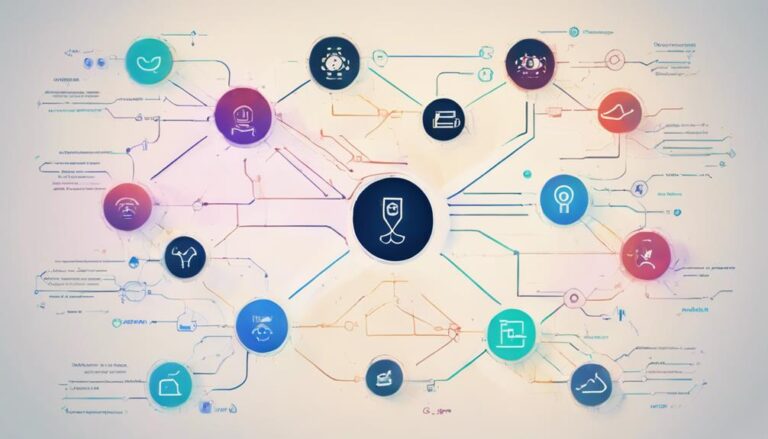Customer journey mapping with technology transforms how we comprehend and refine customer interactions. By using tools like UXPressia and Lucidchart, I can visually map out each touchpoint, from social media to emails. AI enables me to analyze vast amounts of data, predict customer behavior, and personalize experiences. Cloud-based tools guarantee everything is accessible and secure. With AI, I gain real-time insights and save resources through automated mapping. Advanced technologies like AR, VR, and IoT provide even deeper insights, revolutionizing the customer journey. To truly grasp how these tools can boost your strategy, we'll uncover more specifics.
Key Takeaways
- Customer Journey Mapping with technology uses tools like UXPressia and Lucidchart to create detailed visual representations of customer interactions.
- AI enhances mapping by analyzing data to predict behavior patterns, optimizing interactions, and personalizing customer experiences.
- IoT devices provide real-time tracking of customer interactions, offering deep insights and enabling personalized experiences.
- Advanced technologies like AR/VR create immersive, engaging experiences, transforming traditional customer journey mapping.
- Blockchain ensures secure, transparent data sharing, enhancing trust and reliability in customer journey mapping.
Understanding Customer Journey Mapping
In today's competitive landscape, understanding customer journey mapping is essential for businesses aiming to enhance interactions, meet customer needs, and boost overall satisfaction.
Customer journey mapping offers a detailed view of customer interactions, highlighting key touchpoints such as social media, emails, and website visits. By mapping these touchpoints, I can gain actionable insights into customer behaviors and needs, leading to improved customer experience.
Data collection at each touchpoint provides a thorough view of the customer journey, allowing me to identify areas for improvement. Enhancing these key touchpoints can greatly impact satisfaction and revenue, with research showing potential increases of up to 20% in customer satisfaction and 15% in revenue.
Ultimately, mapping is a powerful tool for aligning business strategies with customer expectations.
Role of Technology in Journey Mapping
Leveraging technology, I can transform the insights from customer journey mapping into actionable strategies that elevate the customer experience.
Tools and software like UXPressia and Lucidchart let me create visual representations of customer journeys through customizable templates and real-time collaboration features.
Technology aids in data analysis, helping track interactions and identify critical touchpoints using customer experience and VoC software.
Collaboration tools, such as Miro and Trello, greatly enhance team efficiency in mapping and optimizing these journeys.
Cloud-based tools guarantee that our customer journey maps are accessible and secure, promoting seamless teamwork and data integrity.
AI in Customer Journey Mapping

AI revolutionizes customer journey mapping by analyzing vast amounts of data to predict behavior patterns and optimize interactions. By leveraging AI technology, I can identify trends, preferences, and pain points in the customer journey, which allows me to craft personalized experiences that improve overall satisfaction.
Here's how AI enhances the customer journey:
- Data Analysis: AI automates the collection and analysis of large datasets, offering real-time insights into customer needs and pain points.
- Personalization: By understanding individual preferences, AI tailors interactions to meet specific customer needs, enhancing their experience.
- Feedback Integration: AI processes customer feedback to refine service offerings and address issues promptly.
This innovative approach ultimately leads to a more efficient and effective way to map and improve the customer journey.
Benefits of AI-Powered Mapping
AI-powered mapping offers unparalleled precision and efficiency by analyzing enormous volumes of customer data in real-time, leading to insights that transform the customer journey. By identifying patterns and trends that human analysts might miss, AI-powered mapping provides real-time insights that help predict future behavior.
This allows us to tailor experiences and optimize the customer experience more effectively. Automated mapping saves time and resources, enabling continuous improvements without constant manual intervention. Moreover, AI-driven tools provide personalized recommendations, enhancing interactions at every touchpoint.
Tools for AI-Enhanced Mapping

When I think about AI-enhanced mapping, tools like Smaply and IBM Journey Designer immediately come to mind. These platforms use AI data analysis, predictive analytics, and behavior tracking systems to transform raw data into actionable insights, streamlining the entire customer journey.
AI Data Analysis Tools
Harnessing the power of advanced data analysis tools, businesses can transform customer journey mapping by gaining deeper insights and actionable intelligence. Using Artificial Intelligence (AI) algorithms, these tools process large volumes of data quickly, revealing critical customer behavior patterns.
Through advanced analytics, businesses can:
- Personalize Customer Experience: Leverage real-time data to tailor interactions and improve satisfaction.
- Predict Trends: Identify emerging trends and anticipate customer needs, allowing for proactive adjustments.
- Develop Targeted Marketing Strategies: Utilize insights for precise marketing efforts, boosting conversion rates and revenue.
Predictive Analytics Software
Predictive analytics software, driven by AI and machine learning, offers businesses the ability to foresee future customer behaviors and trends, enabling more informed and empathetic decision-making.
By analyzing historical data, these tools identify patterns and predict customer actions, preferences, and potential churn risks. This foresight optimizes marketing campaigns and enhances personalized interactions, crafting a more tailored Customer Journey.
For instance, recognizing emerging trends helps in adjusting strategies proactively, ensuring higher customer satisfaction and increased ROI. By leveraging AI and machine learning, predictive analytics software transforms raw data into actionable insights, making it indispensable for innovative companies aiming to stay ahead of the curve and deepen their customer relationships.
Behavior Tracking Systems
While predictive analytics software helps us anticipate customer behaviors, behavior tracking systems take it a step further by providing real-time insights into how customers interact with our brand at every touchpoint.
These AI-driven tools capture real-time data to create detailed customer journey maps, highlighting key moments that shape customer decision-making and engagement.
Leveraging this technology allows us to:
- Identify Patterns and Preferences: Recognize common behaviors and preferences to tailor experiences.
- Pinpoint Pain Points: Detect where customers face challenges, enabling us to address and improve these areas.
- Enhance Engagement: Use data-driven analysis to optimize interactions and boost overall customer satisfaction.
Data Collection and Analysis
In order to truly understand and enhance the customer journey, we need to gather and analyze data from a variety of sources, including customer surveys, interviews, and unsolicited data like purchase history and email clicks.
By collecting accurate data on customer interactions, we can create a thorough view of the customer journey. Customer surveys and interviews provide direct insights into each stage of the journey, while unsolicited data such as purchase history and email clicks help fill in the gaps.
Analyzing this data allows us to identify patterns and pain points, enabling us to improve the customer journey with precision. Ultimately, a detailed data collection and analysis strategy is key to innovating and enhancing customer experiences.
Personalization With AI

Leveraging AI to personalize the customer journey allows us to create tailored experiences that greatly enhance engagement and satisfaction. By analyzing customer behavior and individual preferences, AI algorithms predict customer behavior and deliver hyper-personalized content in real-time. This not only optimizes interactions but also drives significant outcomes.
Here are three key benefits:
- Revenue Increase: Personalized experiences can lead to a 15-20% increase in revenue.
- Customer Satisfaction: AI-driven personalization boosts customer satisfaction by 10-15%.
- Real-Time Feedback: AI algorithms adjust customer journeys instantly, ensuring ideal engagement.
AI personalization empowers us to meet customers where they are, enhancing their journey with bespoke solutions that resonate deeply, ultimately driving growth and loyalty.
Future Trends in Journey Mapping
The future of customer journey mapping promises transformative advancements with the integration of cutting-edge technologies like advanced AI, machine learning, and immersive AR/VR experiences. These innovations will create highly personalized customer experiences by leveraging predictive analytics and big data to anticipate needs before they arise.
IoT devices will revolutionize real-time customer interaction tracking, providing deep insights through data analytics. Virtual and augmented reality will offer immersive experiences, making the customer journey more engaging.
Additionally, blockchain technology will guarantee secure and transparent data sharing, enhancing trust and reliability in the process. By embracing these trends, businesses can craft seamless, data-driven customer journeys that not only meet but exceed expectations.
The future is here, and it's data-driven and immersive.
Frequently Asked Questions
What Is Digital Customer Journey Mapping?
Digital customer journey mapping lets me analyze user personas, identify touchpoints, and understand emotional triggers and behavior patterns. By tracking pain points, engagement channels, and conversion paths, I optimize interaction frequency and use customer feedback to enhance experiences.
What Are the 4 Stages of Customer Journey Mapping?
I can't emphasize enough how crucial the 4 stages of customer journey mapping are: Awareness, Consideration, Decision, and Retention. By analyzing customer personas, pain points, and user behavior, we optimize touch points, emotional mapping, and satisfaction metrics.
What Are the 5 Key Components of Customer Journey Map?
When mapping the customer journey, I focus on customer personas, analyzing touchpoints, understanding pain points, and charting the emotional journey. I also set experience goals, examine interaction channels, gather customer feedback, create user scenarios, and develop a service blueprint.
What Are the 7 Steps to Map the Customer Journey?
You won't believe how essential it is to start by identifying customer personas. Next, map touchpoints, journey phases, and user emotions. Focus on pain points, customer goals, experience stages, interaction channels, journey visualization, and finally, map validation.
Conclusion
So, there you have it. Customer journey mapping with AI: because who doesn't want their every move tracked by a soulless algorithm?
But hey, it's all for the sake of personalized experiences, right? The data says we love it, so it must be true.
In the end, it's all about making us feel special—one meticulously mapped, AI-enhanced step at a time.
Welcome to the future, where empathy comes with a side of data analytics.






